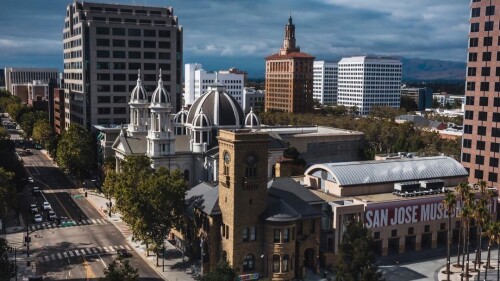You’ve heard of Montgomery Hill Park and John J. Montgomery Elementary School. But, do you know where the name comes from?
Considered as one of the fathers in aviation, John J. Montgomery tested many of his experimental flights right here in San Jose’s backyard.
Let’s look back at how this South Bay trailblazer set the course for future aviators.
A pioneer in aviation
After studying physics at St. Ignatius College in San Francisco, Montgomery + his family moved south of San Diego in 1880 where he began looking at birds in flight and creating early machine models.
By 1883, he had test flown his glider — the first-ever controlled flight of a “heavier-than-air machine” — and coined the design, “aeroplane.” This was, in fact, 20 years before the Wright Brothers flew their plane at Kitty Hawk, NC.
For the next 10 years, Montgomery continued his studies in wing design, air control, and more — the foundation for what became modern aviation.
Back in town
In 1897, Montgomery began teaching wireless telegraphy at Santa Clara College, all while continuing his aeronautic research. By the early 1900s, he — along with several associates — began developing + running tests of his tandem-wing glider, later named “The Santa Clara.”
The glider became the first successful manned gliders to fly, and had performed figure-eights, spirals, and more in front of hundreds of people — at a time when the Wright Brothers had only been maneuvering turns.
With all the data gathered from previous flights, Montgomery developed a new glider called “The Evergreen” in 1911 — named after the area that he tested 50+ successful flights.
Unfortunately, a test flight gone wrong on October 31, 1911 resulted in his untimely death. Montgomery was 53.

This was erected in 1967 to mark the site of 55 successful flights of the “aeroplane” Montgomery flew.
Photo via Wayne Hsieh
His lasting legacy
Now, over 100 years later, Montgomery remains a pioneer in aerodynamics. And you don’t need to look to the sky to see his legacy.
Behind Evergreen Valley College, on the hill where he died, there lies a 30-ft monument of a glider wing in the middle of Montgomery Plaza.
There is also an obelisk monument on Santa Clara University’s campus with quotes from Alexander Graham Bell, Samuel Langley, and more about Montgomery’s daring feat.
Though many US history books credit the Wright Brothers for the first flight, John J. Montgomery, a South Bay native, was the true first pioneer of the skies.











